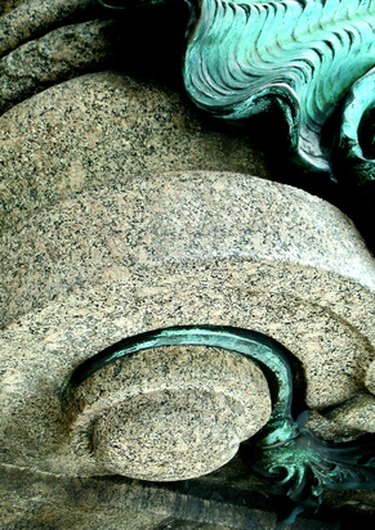
While you can carve and shape stone with just a hammer and a chisel, using the proper tools makes the work much easier and safer. A variety of tools are available from a host of manufacturers, but consider some basics. You'll need to know what sort of stone you're shaping, including its makeup and density, before you can decide what tools are right for the job. Some stones contain hazardous material, and the density of other stones requires specialized tools. Knowing your tools lets you decide the best materials for your project.
Safety Equipment
Video of the Day
Stone chips are sharp, so eye protection and a good pair of gloves are required. When working with pneumatic tools, shock-resistant gloves keep your hands from going numb. Some stones contain toxic materials. Granite, for instance, contains silica, which can cause lung damage when breathed. You'll need a good respirator for granite dust. Ear protection is necessary when working with pneumatic tools or diamond saws.
Video of the Day
Chisels
Point chisels are used to create a rough shape in the stone as well as to get rid of excess material quickly. Tooth chisels are used to refine the rough shape created with the point chisel, such as smoothing the peaks and valleys. Flat chisels further refine the texture of the stone. For softer stones and marbles, a hardened steel chisel works, but harder stones require harder tools. You'll need carbide-tipped chisels for working with materials like granite or sandstone. Pneumatic chisels are much the same, except for use with a pneumatic hammer.
Hammers
The heavier the hammer, the more rough the result. For more detailed work, use a small 1 lb. hammer. For general carving a 1 ½ lb. hammer is good. A 3 lb. hammer is most effective when removing large excess material. Never use a hardened steel hammer to work with hardened steel chisels as too hard a strike could mean metal fragments flying off the end of the chisel. Pneumatic hammers are powered by compressed air, make many strikes per second, and come in varying sizes: ¾-inch and 1-inch hammers are best for general carving, while the 1¼ inch hammer removes large chunks of excess material well.
Handsets and Tracing Tools
Handsets or pitching tools are for knocking away large sections at the edge of a square block of stone. The handset makes this a quicker job and is often very effective. Tracing tools are used on edges which in the final design of your stone. They make precision lines around the edges of a block of stone.
Rasps and Sandpaper
With softer stones, rasps are used for the final shaping. Unlike the power tools used for finishing, the rasp gives more control and creates a more natural look. If you want a smoother finish, sand out rasp marks. Remember when sanding to use wet/dry silicone carbide sandpaper and to apply water to the stone while sanding to keep the dust particles to a minimum. Pneumatic polishers create a more uniform surface and often accept different pads for different grits.
Power Tools
Power tools are available for many of these jobs. Mini-grinders are good for stone carving. Carbide cutting and grinding discs are inexpensive and often used on softer stones, while harder stones require a diamond blade. Die grinders are used for carving softer stones and work well for carving small details. A hammer drill is necessary when drilling stone, and carbide-tipped drill bits are required.